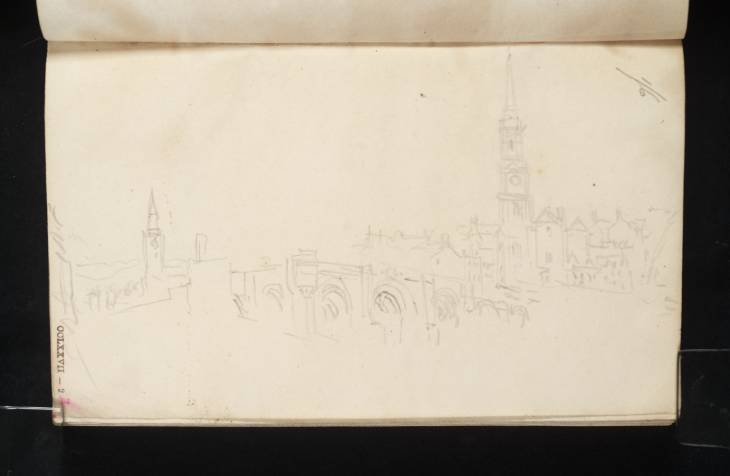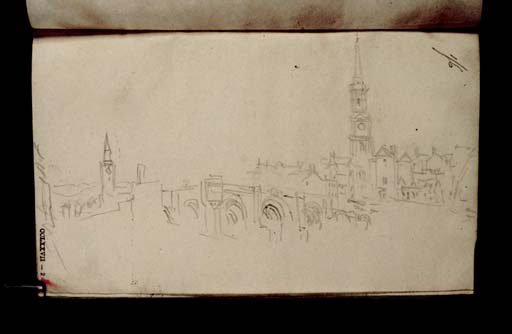J.M.W. Turner
>
1830-35 Annual tourist
>
Scotland 1831
>
Inverness Sketchbook
>
Artwork
Joseph Mallord William Turner Inverness 1831
Image 1 of 2
Joseph Mallord William Turner,
Inverness
1831
Joseph Mallord William Turner 1775–1851
Folio 2 Recto:
Inverness 1831
D27047
Turner Bequest CCLXXVII 2
Turner Bequest CCLXXVII 2
Pencil on off-white wove paper, 104 x 163 mm
Inscribed in brown ink by ?Henry Scott Trimmer ‘1/6’ top right descending vertically
Inscribed in red ink by John Ruskin ‘2’ bottom left descending vertically
Stamped in black ‘CCLXXVII 2’ bottom left descending
Inscribed in brown ink by ?Henry Scott Trimmer ‘1/6’ top right descending vertically
Inscribed in red ink by John Ruskin ‘2’ bottom left descending vertically
Stamped in black ‘CCLXXVII 2’ bottom left descending
Accepted by the nation as part of the Turner Bequest 1856
References
1909
A.J. Finberg, A Complete Inventory of the Drawings of the Turner Bequest, London 1909, vol.II, p.882, CCLXXVII 2, as ‘Inverness. See Engraving, Scott’s Prose Works 1836.’.
A.J. Finberg recognised this sketch as the basis for Turner’s watercolour, Inverness circa 1833 (Inverness Museum and Art Gallery, The Highland Council),1 which was engraved as the frontispiece to Sir Walter Scott’s Tales of a Grandfather, volume 26 of his collected Prose Works.2 Despite this early identification, subsequent publications have sometimes referred to folio 5 (D27052) as the basis for the watercolour,3 although that sketch (despite depicting the two spires seen in the watercolour) is of a different viewpoint. The present sketch, by contrast, is very similar in its viewpoint, composition and detail to the finished watercolour. The view is from the west bank of the River Ness. From here we look across the water to the Ness Bridge (swept away by flood in 1849) in the foreground and Inverness beyond. Dominating the skyline at the right of the sketch is the spire of the Tollbooth on Bridge Street. The more modest spire to the left belongs to the Old High Church (or Kirk).
Turner used these details in his watercolour design along with the buildings surrounding the Tollbooth. He also worked up from memory the few lines denoting part of a wall and the crow-step gables of the building at the far left of the sketch, and the square at the left of the bridge which emerges in the watercolour as a small building with a tall chimney. Two other sketches provided details for the watercolour: from folio 5 he took the boat in the foreground with the figure of a woman on the shore, and he used two boats from folio 7 verso (D27057). Further figures in the foreground were introduced from his memory or imagination. The only significant departure from the present composition is that in the watercolour Turner shifted the viewpoint lower to bring the bridge arches in more extreme perspective, making them larger in the foreground to balance the steeple behind.
Turner stopped at Inverness on his way north to Evanton, where he visited Hugh Munro of Novar House. Perhaps he showed his sketch to Munro, as it was bought by him after the watercolour had been lent to the engraver. Apart from the local interest of the scene, Munro may have been taken by the prominence in the picture of the Tollbooth steeple, which had been partially paid for by his uncle, Sir Hector Munro (1726–1805), who had been Member of Parliament for Inverness Burghs and had built the Novar estate.
Further sketches of Inverness are on folios 3–4, 5–6 verso, 7 verso, 8, 9 and 9 verso (D27048–D27050, D27052–D28055, D27057, D27060, D27061, D27062).
Verso:
Blank
Thomas Ardill
April 2010
How to cite
Thomas Ardill, ‘Inverness 1831 by Joseph Mallord William Turner’, catalogue entry, April 2010, in David Blayney Brown (ed.), J.M.W. Turner: Sketchbooks, Drawings and Watercolours, Tate Research Publication, December 2012, https://www


